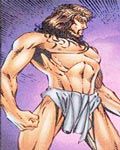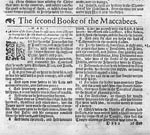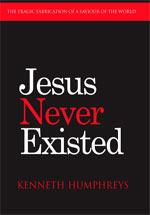Man or Myth?
JC can be anything you want him to be, hippy humanitarian or Lord of Hosts. Great, eh?
Dead Sea Scrolls
Between 1947-1956 more than 800 ancient documents – nearly all in fragments – were retrieved from caves near the ruins of Khirbet Qumran on the northwest shore of the Dead Sea.
Early copies of Jewish scripture (notably Isaiah) proved to be an obvious delight to the state of Israel, particularly as the discoveries coincided with the country's foundation.
But the really interesting finds were the "sectarian" scrolls which reveal the machinations of rival groups during the birth pangs of Christianity.
The orthodox Old Testament texts from Qumran were published readily enough.
But the "sectarian" material was successfully hidden from scrutiny for nearly half a century by a cabal of Dominican scholars of the Ecole Biblique and an approved "international team" of Catholic and Jewish academics.
God knows what material was spirited away to the bowels of the Vatican or simply destroyed.
First "Christ"?
The Persian 'King of Kings' Cyrus the Great (580-529 BC) was an early saviour of the Jews.
Illustrious King ...
Antiochus Epiphanes – modernising policies favoured urban elite.
... versus Rabid Extremist
Mattathias – began Maccabean war (and the long road to "Jesus") by murdering an apostate fellow Jew.
"Let everybody who is zealous for the law and stands by the covenant follow me"
– I Maccabees 2:27.
From the Dead Sea Scrolls
• Community Rule or 'Manual of Discipline' ('MD')
= The rules of initiation, liturgy, religious duties, and penal code for a counter-priesthood.
The oldest of the scrolls, perhaps parts as early as 2nd century BC. But some additions as late as 1st century AD.
• Messianic Rule (The Rule of the Congregation - 1Q28a) (mid-1st century BC).
= The rules for the "last of days" for the "sons of Zadok".
The "Messiah of Israel" is a political leader, subordinate to the High Priest. Together they lead a Council, effectively "pillars of the Community".
II Maccabees – ideas about resurrection, judgment by God, and eternal life for those judged worthy.
The Jewish "Alexander"
Hasmonaean coin of "Yehonatan the King" (Alexander Jannaeus, 103-76 BC)
The 8-pointed star within a diadem is a Hellenistic symbol of kingship.
"I shall see him, but not now: I shall behold him, but not nigh: there shall come a Star out of Jacob, and a Sceptre shall rise out of Israel, and shall smite the corners of Moab, and destroy all the children of Sheth."
– Numbers 24.17.
Alexander Jannaeus – brutal Maccabean king crucified his enemies, including quite probably the Essene leader and early role model for JC.
Golgotha – Place of Skulls
From the "Damascus Document"
Crucifixion!
"Thus you shall eradicate all evil in your midst, and all the children of Israel shall hear it and fear ...If there were a man with a sin punishable by death and he escapes amongst the nations and curses his people, the children of Israel, he also you shall crucify and he shall die...
They are cursed by God and man, those crucified; thus you shall not defile the land which I give you."
– CD 64.6-12
From the Dead Sea Scrolls
• Commentary on the Book of Habakkuk. Describes the struggle between the Teacher of Righteousness and his two opponents, the Spouter of Lies and the Wicked Priest.
On the Wicked Priest:" The city is Jerusalem, in which the wicked priest did works of abomination and defiled the Temple of God."
- lQpHab 12.7-9
Was Jesus, like Alexander the Great or Julius Caesar, a real historical figure to whom legends and myths became attached? Or, rather, like Huckleberry Finn or Sherlock Holmes a purely fictional character, passed off as a genuine personage or later historicized by other hands? Perhaps the choice is not quite so clear cut: a person (perhaps several) were certainly in the mind of Mark Twain and Sir Arthur Conan Doyle when they constructed their heroes. Twain drew inspiration from his own life. Doyle modelled much of the character of his detective on his own professor of medicine, a Dr Joseph Bell. Did that make Sherlock Holmes any less of a fiction? (Interestingly, Holmes's trademark “deerstalker” hat is never mentioned in Doyle's stories and the drop-step pipe was the contribution of actor William Gillette years later. That's how myths grow.) With Jesus, most people feel more comfortable with the 'historical kernel' approach. It is intuitively satisfying to think that someone was behind the towering legend. We do, after all, have Christianity, and it is hard to give credence to the idea that someone "just made-up" Jesus Christ and then managed to convince anyone else to believe that he had lived and died. In fact, one can reach the conclusion that "there must have been a Jesus" without any research at all, which of course is what most people do.
|
|||||||||||||||||||||||||||||||||||||||||||||||||||
|
Convinced that they were themselves the 'Elect of God' who would therefore inherit God's kingdom, the Elders took it upon themselves to interpret allegorically the Jewish scriptures hitherto understood literally.
Their anticipation and hope was that in a not too distant future a priestly messiah would arise, a sage who would correctly interpret the Law of Moses, heal the sick, and predict the future. His presence would signal the imminence of God's kingdom.
Like latter-day cadres of Al Qaeda, the Zadokite/Essenes readied themselves for this coming conflict (of "Light and Darkness") with a diet of pious devotions and military training.
From Daniel they took the phrase "one like a man" and rendered a new title for their soon-to-arrive hero "Son of Man", he who would usher in God's Kingdom and restore the rightful bloodlines.
Pharisees – "Universal King, Raising the Dead"
About the same time that the Zadokites/ Essenes fled to the badlands another faction of the priesthood also broke from the Hasmoneans – taking the name Pharisees ('separate ones'), referred to in the coded language of the Dead Sea Scrolls as 'seekers of smooth things'.
Austere, and devoted to strict religious observance, the Pharisees fiercely resented foreign influence in their land. Their sensibilities were especially offended by the impiety of the ruling house and caused these otherwise religious conservatives to augment existing scripture with contemporary reinterpretations known as "oral law."
Abandoning the Hasmonean dynasty the Pharisees declared faith in and expectation of a future ideal and even universal king, one who would act as God's special agent, a true "Son of God." (The phrase will subsequently appear 81 times in the Gospels).
Persecuted by the royalists, they also became part of the pious resistance, a movement which now awaited two saviours, just as "foretold" by Zechariah:
"Then said he, These are the two anointed ones, that stand by the LORD of the whole earth."
– Zechariah 4.14.
II Maccabees,
written about this time, recorded the sentiments of the
Pharisees. To the Pharisees belongs
the dubious honour of inventing the concept of Holy War, a conviction
that faith will lead the righteous into martyrdom and that it
is their martyrdom which will prompt God to act.
Again, Daniel served a purpose. The prophet's overnight stay in the lions' den (6.16) – as also the very similar "three men in the oven" story (3.19,30) – were now interpreted with a subtle scriptural inventiveness. It was not merely Israel which would be restored by the Almighty's beneficence; God had established a covenant with his "Elect". When they made the ultimate sacrifice He would deliver them of a personal resurrection.
God vouchsafed a new eternal life to his martyrs.
|
Alexander's Massacre – "Scapegoat Sacrifice"
Core support for the Maccabean royal house came from the aristocratic party of Sadducees. In principle, its members were firmly committed to the teachings of the written Torah. They rejected the innovations of "oral law" and the unsettling extremist notion of resurrection of the body after death.
The clash of the reality of earthly power and the cohorts of frustrated piety reached a brutal climax during the reign of Alexander Jannaeus (103-76 BC), nicknamed the "Thracian" for his use of Greek mercenaries. Jerusalem-based Pharisees took advantage of a military reversal for Alexander to lead a rebellion.
The sedition became a 6-year civil war. But the brethren had underestimated their ruthless opponent and even intervention by the Syrian king Demetrius on their behalf failed to save them. Rather, it ensured the vengeance of Alexander.
Having driven out the Syrians, around the year 88 BC some 800 Pharisee and Essene captives held by Alexander were crucified within sight of the palace in Jerusalem (giving rise to the name of the killing field "Mount of Execution" or Gol Goatha).
The Essene
leader at this time, never named but referred to in their scrolls
as the 'Teacher
of Righteousness' quite probably was
among Alexander's victims. An Essene commentary
on the Book of Habakkuk found at Qumran makes reference
to the "Wicked Priest's" persecution of the
Teacher of Righteousness and of another adversary, "the
Liar". Josephus records of the Jewish priest/king:
"When he had taken the city, and gotten the men into his power, he brought them to Jerusalem, and did one of the most barbarous actions in the world to them;
for as he was feasting with his concubines, in the sight of all the city, he ordered about eight hundred of them to be crucified; and while they were living, he ordered the throats of their children and wives to be cut before their eyes."
– Josephus, Antiquities of the Jews, 13.14.
Initially
the Elect had been stunned and shocked by the execution of
their Righteous Teacher. To the Essenes,
Alexander was the "Lion of Wrath," his tyranny a time
of trial. But on the other hand it was also a sure sign of the "Last
of Days".
Such is the nature of creative piety,
from the setback the priests were able to fabricate a positive
spiritual riposte: the notion of a propitiatory sacrifice.
God had allowed the death of their leader as a sign of his redeeming love!
Strange as it may seem, the Almighty achieves his purposes through the suffering of his servants. But of course the notion is no more than ancient scapegoat sacrifice – someone chosen to pay the blood-price. Poetry (ascribed to the Teacher) records this enlightening dogma:
"From Thee it is that they threaten my life,
That thou mayest be glorified by the judgement of the wicked,
and demonstrate Thy might through me ..."– Allegro, The Dead Sea Scrolls, p90.
Updating 'Isaiah' – "Suffering Servant"
Quite possibly, it was at this time that another, more famous, poetic work, Isaiah, gained those verses used to such great effect in a later age in the fabrication of "Jesus Christ."
Isaiah is a rambling, disjointed work of many hands, recording as contemporary events the dramas of more than two centuries. The Lord's "servant" of chapter 50 (Israel?) becomes by chapter 53 a man suffering the fate of the Teacher:
"Who hath believed our report? ... he was wounded for our transgressions, he was bruised for our iniquities ... with his stripes we are healed ...
the LORD hath laid on him the iniquity of us all ... He was taken from prison and from judgment ... it pleased the LORD to bruise him;
he hath put him to grief ... by his knowledge shall my righteous servant justify many; for he shall bear their iniquities ... he bare the sin of many, and made intercession for the transgressors."
– Isaiah 53
As the decades and centuries unfolded all the story elements
which would eventually coalesce into the legend of Christ came
into being. Each political and national crisis of the Jews engendered
a restatement and a recasting of a perennial theme.
The priestly authors of the Christ myth were not inventors – they were plagiarists.
Sources:
J. R. Porter, The Lost Bible (Duncan Baird, 2001)
John Allegro, The Dead Sea Scrolls and the Christian Myth (Westbridge,
1979)
M. Baigent, R. Leigh, The Dead Sea Scrolls Deception (Jonathan Cape, 1992)
Don Fleming, Bible Knowledge Dictionary (Scripture Press, 1990)
Luigi Cascioli, The Fable of Christ (Luigi Cascioli, 2001)
David Watson, Jesus, then and Now (Lion, 1983)
W. P. Ball, et al, The Bible Handbook (AAP, 1986)
Nicholas Carter, The Christ Myth (Historical Review Press, 1993)
Keith Hopkins, A World Full of Gods (The Free Press, 2000)
|
||||||||||||||||||||||||||||||||||||||||
|
|
|
||
'Save' a friend e-mail this page















